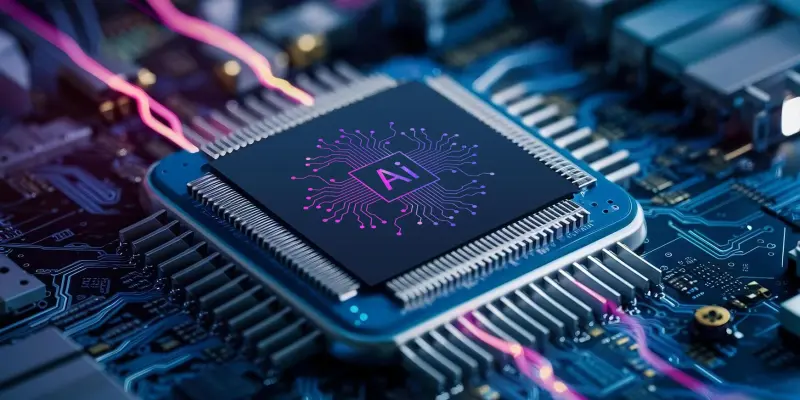Huawei’s ascendancy in the AI chip industry posits a bold challenge to the existing dominance exerted by NVIDIA, as the Chinese tech giant prepares to unleash its Ascend 910C AI chips, designed to outstrip NVIDIA’s current capabilities. This new development showcases Huawei’s determination to revolutionize artificial intelligence technologies and claim the top spot in the AI market. Central to Huawei’s strategy is the integration of these cutting-edge AI chips into the CloudMatrix 384 AI cluster, which features an advanced topology configuration aimed at delivering unprecedented performance. The substantial computational prowess of the CloudMatrix 384 AI cluster exemplifies Huawei’s commitment to maximizing raw computational power, even at the cost of increased energy consumption.
CloudMatrix 384 AI Cluster: Performance vs. Efficiency
Huawei’s CloudMatrix 384 AI cluster, which incorporates 384 Ascend 910C chips in a sophisticated all-to-all topology arrangement, promises to set new benchmarks in AI computational power. This cluster is claimed to outperform NVIDIA’s GB200 NVL72 AI server, positioning Huawei at the forefront of AI innovation. However, this remarkable advancement comes at a significant energy cost; the CloudMatrix 384 consumes nearly four times the power of NVIDIA’s server, raising questions about its long-term feasibility and impact on energy resources. Despite the high power demands, China’s robust power generation capabilities mitigate these concerns. By prioritizing performance over cost-efficiency, Huawei underscores its unwavering commitment to achieving superiority in AI technology, signaling a readiness to forsake traditional efficiency metrics for raw power.
China’s drive towards technological self-reliance further accentuates Huawei’s strategic positioning. The CloudMatrix 384 AI cluster is tailored explicitly for the domestic market, ensuring minimal dependence on foreign companies and fostering an environment of innovation and competitiveness within China. Huawei’s focus on developing high-performance AI solutions aimed at addressing China’s significant computational requirements indicates a broader ambition of national self-sufficiency in technology. This strategic move not only bolsters the domestic AI industry but also enables China to compete more effectively on the global stage.
Implications for Global AI Competition
Huawei’s advancements represent more than just technological innovation; they reflect an overarching trend of intense rivalry between domestic Chinese firms and Western entities in the AI sector. The introduction of the Ascend 910C chips and CloudMatrix 384 cluster exemplifies the competition-driven landscape that is reshaping global AI dynamics. Restrictions on accessing certain markets notwithstanding, Huawei’s progress indicates substantial strides in technology that could potentially alter the balance of power in the AI realm. This evolution fosters a competitive environment where innovation is paramount and contributes to the global race for AI supremacy.
Huawei’s ambitious pursuit of technological dominance entails several implications for the future of AI development. The increased computational capabilities embodied by the CloudMatrix 384 cluster could catalyze advancements in various fields requiring intensive AI applications, potentially leading to breakthroughs in industries ranging from healthcare to autonomous transportation. However, the accompanying high energy consumption raises critical discussions about sustainable AI practices and balancing power efficiency with performance. These considerations may drive future innovations aimed at optimizing energy use without compromising computational power. In essence, Huawei’s strides highlight the dynamic nature of the AI sector, where innovation and competition catalyze significant technological progress. The Ascend 910C chips and CloudMatrix 384 cluster signify a notable leap forward for China’s AI industry, serving as a testament to the nation’s ambition to achieve tech self-sufficiency and present a formidable challenge to Western giants like NVIDIA. This development underscores a pivotal moment in the global AI landscape, setting the stage for further advancements and intensified competition.
Summary of Key Takeaways
Huawei’s rise in the AI chip industry presents a formidable challenge to NVIDIA’s dominance, as the Chinese tech behemoth is set to launch its Ascend 910C AI chips. These chips are engineered to surpass NVIDIA’s current offerings, signaling Huawei’s ambition to significantly impact artificial intelligence technologies and secure a leading position in the AI market. Central to Huawei’s plan is the deployment of these elite AI chips within the CloudMatrix 384 AI cluster. This advanced AI cluster boasts a sophisticated topology configuration, designed to deliver unmatched performance capabilities. The impressive computational strength of the CloudMatrix 384 AI cluster underscores Huawei’s dedication to achieving maximum raw computational capacity, even if it involves higher energy consumption. This move highlights the company’s strategic emphasis on pioneering AI advancements, aiming to set new industry standards and redefine the competitive landscape. Huawei’s relentless focus on innovation and performance underlines its resolve to outpace competitors and define the future of artificial intelligence.

